Important Questions and choose the correct answer - Botany - Classical Genetics: Evaluation | 12th Botany : Chapter 2 : Classical Genetics
Chapter: 12th Botany : Chapter 2 : Classical Genetics
Classical Genetics: Evaluation
Botany : Classical Genetics
Choose the Correct Answers
1. Extra nuclear inheritance is a consequence of presence of genes in
a) Mitrochondria and chloroplasts
b) Endoplasmic reticulum and mitrochondria
c) Ribosomes and chloroplast
d) Lysososmes and ribosomes
2. In order to find out the different types of gametes produced by a pea plant having the genotype AaBb, it should be crossed to a plant with the genotype
a) aaBB
b) AaBB
c) AABB
d) aabb
3. How many different kinds of gametes will be produced by a plant having the genotype AABbCC?
a) Three
b) Four
c) Nine
d) Two
4. Which one of the following is an example of polygenic inheritance?
a) Flower colour in Mirabilis Jalapa
b) Production of male honey bee
c) Pod shape in garden pea
d) Skin Colour in humans
5. In Mendel’s experiments with garden pea, round seed shape (RR) was dominant over wrinkled seeds (rr), yellow cotyledon (YY) was dominant over green cotyledon (yy). What are the expected phenotypes in the F2 generation of the cross RRYY x rryy?
a) Only round seeds with green cotyledons
b) Only wrinkled seeds with yellow cotyledons
c) Only wrinkled seeds with green cotyledons
d) Round seeds with yellow cotyledons an wrinkled seeds with yellow cotyledons
6. Test cross involves
a) Crossing between two genotypes with recessive trait
b) Crossing between two F1 hybrids
c) Crossing the F1 hybrid with a double recessive genotype
d) Crossing between two genotypes with dominant trait
7. In pea plants, yellow seeds are dominant to green. If a heterozygous yellow seed pant is crossed with a green seeded plant, what ratio of yellow and green seeded plants would you expect in F1 generation?
a) 9:1
b) 1:3
c) 3:1
d) 50:50
8. The genotype of a plant showing the dominant phenotype can be determined by
a) Back cross
b) Test cross
c) Dihybrid corss
d) Pedigree analysis
9. Select the correct statement from the ones given below with respect to dihydrid cross
a) Tightly linked genes on the same chromosomes show very few combinations
b) Tightly linked genes on the same chromosomes show higher combinations
c) Genesfarapartonthesamechromosomes show very few recombinations
d) Genes loosely linked on the same chromosomes show similar recombinations as the tightly linked ones
10. Which Mendelian idea is depicted by a cross in which the F1 generation resembles both the parents
a) Incomplete dominance
b) Law of dominance
c) Inheritance of one gene
d) Co-dominance
11. Fruit colour in squash is an example of
a) Recessive epistatsis
b) Dominant epistasis
c) Complementary genes
d) Inhibitory genes
12. In his classic experiments on Pea plants, Mendel did not use
a)Flowering position
b) Seed colour
c) Pod length
d) Seed shape
13. The epistatic effect, in which the dihybrid cross 9:3:3:1 between AaBb Aabb is modified as
a) Dominance of one allele on another allele of both loci
b) Interaction between two alleles of different loci
c) Dominance of one allele to another alleles of same loci
d) Interaction between two alleles of some loci
14. In a test cross involving F1 dihybrid flies, more parental type offspring were produced than the recombination type offspring. This indicates
a) The two genes are located on two different chromosomes
b) Chromosomes failed to separate during meiosis
c) The two genes are linked and present on the some chromosome
d) Both of the characters are controlled by more than one gene
15. The genes controlling the seven pea characters studied by Mendel are known to be located on how many different chromosomes?
a) Seven
b) Six
c) Five
d) Four
16. Which of the following explains how progeny can posses the combinations of traits that none of the parent possessed?
a) Law of segregation
b) Chromosome theory
c) Law of independent assortment
d) Polygenic inheritance
17. “Gametes are never hybrid”. This is a statement of
a) Law of dominance
b) Law of independent assortment
c) Law of segregation
d) Law of random fertilization
18. Gene which suppresses other genes activity but does not lie on the same locus is called as
a) Epistatic
b) Supplement only
c) Hypostatic
d) Codominant
19. Pure tall plants are crossed with pure dwarf plants. In the F1 generation, all plants were tall. These tall plants of F1 generation were selfed and the ratio of tall to dwarf plants obtained was 3:1. This is called
a) Dominance
b) Inheritance
c) Codominance
d) Heredity
20. The dominant epistatis ratio is
a) 9:3:3:1
b) 12:3:1
c) 9:3:4
d) 9:6:1
21. Select the period for Mendel’s hybridization experiments
a) 1856 - 1863
b) 1850 - 1870
c) 1857 - 1869
d) 1870 - 1877
22. Among the following characters which one was not considered by Mendel in his experimentation pea?
a) Stem – Tall or dwarf
b) Trichomal glandular or non-glandular
c) Seed – Green or yellow
d) Pod – Inflated or constricted
Answer the following questions
23. Name the seven contrasting traits of Mendel.
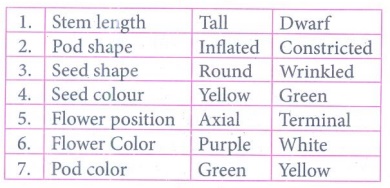
24. What is meant by true breeding or pure breeding lines / strain?
Answer: A true breeding line means it has undergone continuous self pollination having stable trait inheritance from parent to offspring.
25. Give the names of the scientists who rediscovered Mendelism.
Answer: (i) Hugo de Vries - Holland
(ii) Carl Correns - Germany
(iii) Erich von Tschermak - Austria
26. What is back cross?
Answer: (i) Back cross is a cross of F1 hybrid with one of the parental genotypes. The back cross is of two types; they are dominant back cross and recessive back cross.
(ii) It involves the cross between the F1 off spring with either of the two parents.
(iii) The recessive back cross helps to identify the heterozygosity of the hybrid.
27. Define Genetics.
Answer: Genetics is the branch of biological science which deals with mechanism of transmission of characters from parents to offsprings.
28. What are multiple alleles
Answer: Three or more allelic forms of a gene occupy the same locus in a given pair of homologous chromosomes.
29. What are the reasons for Mendel’s successes in his breeding experiment?
Answer: (i) He applied mathematics and statistical methods to biology and laws of probability to his breeding experiments.
(ii) He followed scientific methods and kept accurate and detailed records that include quantitative data of the outcome of his crosses.
(iii) His experiments were carefully planned and he used large samples.
(iv) The pairs of contrasting characters which were controlled by factor (genes) were present on separate chromosomes.
(v) The parents selected by Mendel were pure breed lines and the purity was tested by self crossing the progeny for many generations.
30. Explain the law of dominance in monohybrid cross.
Answer: (i) These characters are controlled by discrete units called factors which occurs in pairs.
(ii) In a dissimilar pair of factors one member of two pair is dominant and the other is recessive.
(iii) This law gives an explanation to the monohybrid cross (a) the expression of only one of the parental characters in F1 generation and (b) the expression of both in F2 generation.
(iv) It is also explains the proportion of 3:1 obtained at the F2.
31. Differentiate incomplete dominance and codominance.
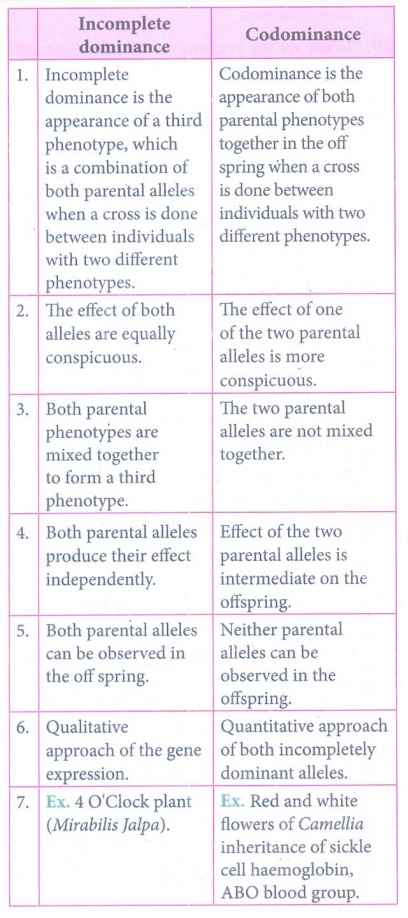
Answer:
Incomplete dominance
1. Incomplete dominance is the appearance of a third phenotype, which is a combination of both parental alleles when a cross is done between individuals with two different phenotypes.
2. The effect of both alleles are equally conspicuous.
3. Both parental phenotypes are mixed together to form a third phenotype.
4. Both parental alleles produce their effect independently.
5. Both parental alleles can be observed in the off spring.
6. Qualitative approach of the gene expression.
7. Ex. 4 O’Clock plant (Mirabilis Jalpa).
Codominance
1. Codominance is the appearance of both parental phenotypes together in the off spring when a cross is done between individuals with two different phenotypes.
2. The effect of one of the two parental alleles is more conspicuous.
3. The two parental alleles are not mixed together.
4. Effect of the two parental alleles is intermediate on the offspring.
5. Neither parental alleles can be observed in the offspring.
6. Quantitative approach of both incompletely dominant alleles.
7. Ex. Red and white flowers of Camellia inheritance of sickle cell haemoglobin, ABO blood group.
32. What is meant by cytoplasmic inheritance
Answer: (i) DNA is the universal genetic material.
(ii) Genes located in nuclear chromosomes follow, mendelian inheritance.
(iii) But certain traits are governed either by the chloroplast or mitochondrial genes. This phenomenon is known as extra nuclear inheritance. It is a kind of Non-Mendelian inheritance.
(iv) Since it involves cytoplasmic organelles such as chloroplast and mitochondrion that act as inheritance vectors, it is also called Cytoplasmic inheritance.
(v) It is based on independent, self-replicating extra chromosomal unit called plasmogene located in the cytoplasmic organelles, chloroplast and mitochondrion.
33. Describe dominant epistasis with an example.
Answer: Dominant Epistasis:
(i) It is a gene interaction in which two alleles of a gene at one locus interfere and suppress or mask the phenotypic expression of a different pair of alleles of another gene at another locus.
(ii) The gene that suppresses or masks the phenotypic expression of a gene at another locus is known as epistatic.
(iii) The gene whose expression is interfered by non-allelic genes and prevents from exhibiting its character is known as hypostatic.
(iv) When both the genes are present together, the phenotype is determined by the epistatic gene and not by the hypostatic gene.
(v) In the summer squash the fruit colour locus has a dominant allele ‘W’ for white colour and a recessive allele ‘w’ for coloured fruit. ‘W’ allele is dominant that masks the expression of any colour.
(vi) In another locus hypostatic allele ‘G’ is for yellow fruit and its recessive allele ‘g’ for green fruit. In the first locus the white is dominant to colour where as in the second locus yellow is dominant to green.
(vii) When the white fruit with genotype WWgg is crossed with yellow fruit with genotype wwGG, the F1 plants have white fruit and are heterozygous (WwGg). When F1 heterozygous plants are crossed they give rise to F2 with the phenotypic ratio of 12 white : 3 yellow : 1 green.
(viii) Since W is epistatic to the alleles ‘G’ and ‘g’, the white which is dominant, masks the effect of yellow or green.
(ix) Homozygous recessive ww genotypes only can give the coloured fruits (4/16). Double recessive ‘wwgg’ will give green fruit (1/16).
(x) The Plants having only ‘G’ in its genotype (wwGg or wwGG) will give the yellow fruit (3/16).
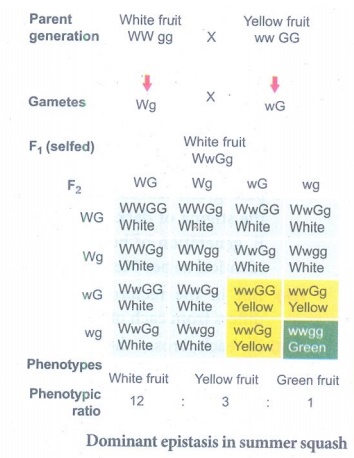
Dominant epistasis in summer squash
34. Explain polygenic inheritance with an example.
Answer: Polygenic Inheritance:
(i) Polygenic inheritance - Several genes combine to affect a single trait.
(ii) A group of genes that together determine (contribute) a characteristic of an organism is called polygenic inheritance.
(iii) It gives explanations to the inheritance of continuous traits.
(iv) The first experiment on polygenic inheritance was demonstrated by Swedish Geneticist H. Nilsson - Ehle (1909) in wheat kernels.
(v) Kernel colour is controlled by two genes each with two alleles. One with red kernel colour was dominant to white.
(vi) He crossed the two pure breeding wheat varieties dark red and a white. Dark red genotypes R1R1R2R2 and white genotypes are r1r1r2r2.
(vii) In the F1 generation medium red were obtained with the genotype R1r1R2r2. F1 wheat plant produces four types of gametes R1R2, R1r2, r1R2, r1r2.
(viii) The intensity of the red colour is determined by the number of R genes in the F2 generation.
Four R genes: A dark red kernel colour is obtained.
Three R genes: Medium - dark red kernel colour is obtained.
Two R genes: Medium-red kernel colour is obtained.
One R gene: Light red kernel colour is obtained.
Absence of R gene: Results in White kernel colour. The R gene in a additive manner produces red kernel colour.
35. Differentiate continuous variation with discontinuous variation.
Answer:
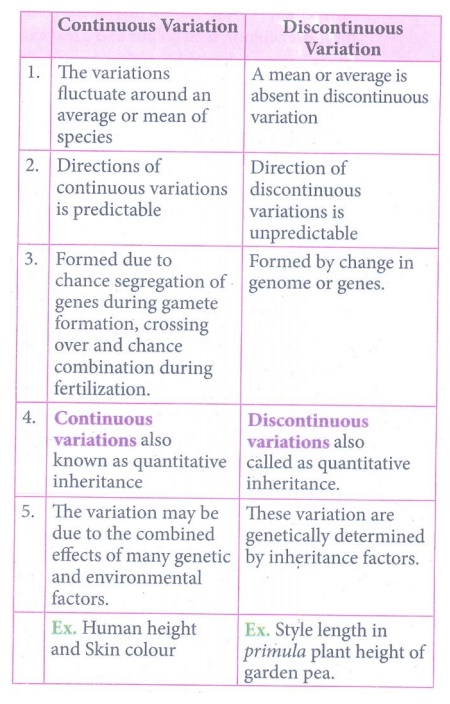
Continuous Variation
1. The variations fluctuate around an average or mean of species
2. Directions of continuous variations is predictable
3. Formed due to chance segregation of genes during gamete formation, crossing over and chance combination during fertilization.
4. Continuous variations also known as quantitative inheritance
5. The variation may be due to the combined effects of many genetic and environmental factors.
Ex. Human height and Skin colour
Discontinuous Variation
1. A mean or average is absent in discontinuous variation
2. Direction of discontinuous variations is unpredictable
3. Formed by change in genome or genes.
4. Discontinuous variations also called as quantitative inheritance.
5. These variation are genetically determined by inheritance factors.
Ex. Style length in primula plant height of garden pea.
36. Explain with an example how single genes affect multiple traits and alleles the phenotype of an organism.
Answer: Pleiotropy - A single gene affects multiple traits:
(i) In Pleiotropy, the single gene affects multiple traits and alter the phenotype of the organism.
(ii) The Pleiotropic gene influences a number of characters simultaneously and such genes are called pleiotropic gene.
(iii) Mendel noticed pleiotropy while performing breeding experiment with peas (Pisum sativum).
(iv) Peas with purple flowers, brown seeds and dark spot on the axils of the leaves were crossed with a variety of peas having white flowers, light coloured seeds and no spot on the axils of the leaves. The three traits for flower colour, seed colour and a leaf axil spot all were inherited together as a single unit.
(v) This is due to the pattern of inheritance where the three traits were controlled by a single gene with dominant and recessive alleles.
Example: sickle cell anemia.
37. Bring out the inheritance of chloroplast gene with an example.
Answer: Chloroplast Inheritance:
(i) DNA is the universal genetic material. Genes located in nuclear chromosomes follow Mendelian inheritance. But certain traits are governed either by the chloroplast or mitochondrial genes known as extra nuclear inheritance.
(ii) It is a kind of Non-Mendelian inheritance. Since it involves cytoplasmic organelles such as chloroplast that act as inheritance vectors, it is also called Cytoplasmic inheritance.
(iii) It is based on independent, self-replicating extra chromosomal unit called plasmogene located in the chloroplast.
(iv) It is found in 4 O’ Clock plant (Mirabilis jalapa).
(v) Two types of variegated leaves namely (i) Dark green leaved plants (ii) Pale green leaved plants.
(vi) When the pollen of dark green leaved plant (male) is transferred to the stigma of pale green leaved plant (female) and pollen of pale green leaved plant is transferred to the stigma of dark green leaved plant, the F1 generation of both the crosses must be identical as per Mendelian inheritance.
(vii) But in the reciprocal cross the F1 plant differs from each other.
(viii) In each cross, the F1 plant reveals the character of the plant which is used as female plant.
(ix) This inheritance is not through nuclear gene. It is due to the chloroplast gene found in the ovum of the female plant which contributes the cytoplasm during fertilization since the male gamete contribute only the nucleus but not cytoplasm.
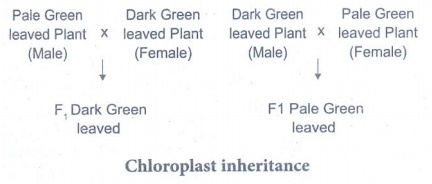
Related Topics